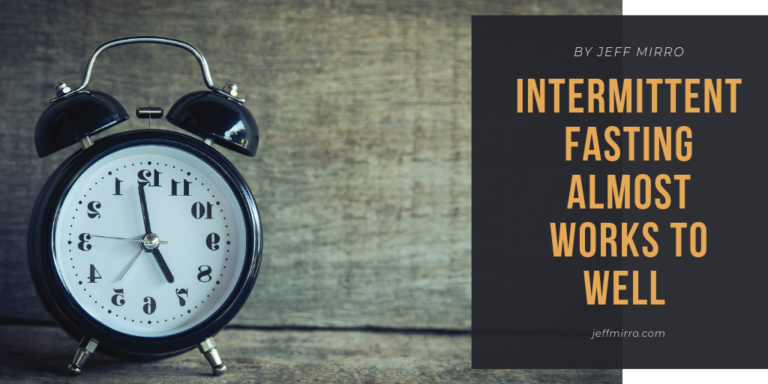Even after you reach your weight loss goal, intermittent fasting maintenance can be difficult. Sticking to your fasting-focused lifestyle does not have to be difficult though. You just need to have the right mindset, and the right habits in place so that you never give it up, and you never sabotage the results you’ve achieved. If you’re new to fasting or even if you’ve been doing it for a while and are just looking to reinforce your fasting-focused lifestyle with some more fasting knowledge, read the post below…
Intermittent Fasting Maintenance
An increasing number of studies are showing that it’s not just what you eat but how often and when you eat that matters when it comes to your health. Fasting has been practiced for thousands of years both as a way of life and for religious reasons. It’s only in recent years, however, that people have begun eyeing fasting as a legitimate lifestyle for health reasons. Skipping meals can be tough in a society where food is everywhere.
Even when fasting is working for you, you might find yourself reaching a plateau. How do you stay motivated to stick with your fasting-focused lifestyle when the going gets tough?
Knowing It’s the Right Choice
Diets come and go, and fad diets come and go even faster. How can you be confident that IF is the right choice for your body? First, you might be happy to know that IF isn’t a diet. It’s a lifestyle, and it’s one that has the backing of plenty of scientific studies not just for weight loss but for overall health and wellness.
One study found that just fasting on alternate days could be as beneficial for weight loss and even maintaining the loss for people who are obese. For those with pre-diabetes, fasting was also found to help lower cholesterol levels. In mice models, restricting food by time, or fasting can improve how the body uses nutrients, preventing obesity, diabetes, inflammation and other metabolic problems.
IF can help you gain control of your weight, your body, and your future. What’s not to love about that?
Fasting in a Way that Works for You
Not every kind of fasting-focused lifestyle works for every person. Some prefer one meal a day while others opt for dry fasting. Other people might prefer the flexibility of 18:6. How you fast depends on your goals or your preferences. It also depends on where you are in your personal journey.
While eating once a day might sound hard-core, it’s really the healthiest IF method. When you eat just one meal in 24 hours, your body will pump up to 1,500 percent more HGH every day and save more time and money, but you won’t feel overly deprived.
18:6 gives you a little more wiggle room with two meals a day. You’ll still save money and time with TMAD, but you’ll get to have one more meal or snack a day. Your weight or fat loss is likely to be a bit slower, but you’ll still see results.
Dry fasting is one other option. During a dry fast, you’ll go without food or water. This is an extreme type of fast that isn’t designed to last for a long period, but it does force your body’s cells to compete for scarce resources. The strong cells will survive and the weaker or diseased cells will die off thanks to increased macrophage activity.
Autophagy is the result of a hardcore fast that requires 16 to 36 hours at a minimum or 24 to 48 hours for optimum results. The goal of autophagy is to stimulate macrophages, the body’s cleanup crew. Once these little cells are activated, they’ll destroy diseased cells and renew damaged cells, and your insulin resistance and inflammatory markers will decrease.
No matter what type of fast you choose, you need to choose one that feels right for you and your lifestyle and listen to your body. If you’re dry fasting, skip intense exercise that could lead to dehydration and keep workouts brief. If you’re unwell, follow your instincts, and eat nutrient-dense foods to restore your health.
Eating for Fuel
Intermittent fasting is not a free-for-all or permission to eat whatever you want, although to be honest, you can get away with a lot more unhealthy eating habits when you fast (more on this in my post next week). You need to give your body nutritious foods to fuel it during your fast. While just about any diet plan can work with OMAD and other fasts, low-carb, keto and carnivore-type diets tend to offer the most effective results. The high-fat and high-protein content of these strategies will keep you sated for hours while the low-carb veggies are great sources of the vitamins your body needs.
Good choices for intermittent fasting maintenance include:
- Grass-fed meats
- Poultry
- Salmon, mackerel and other fatty fish
- Shrimp and crab
- Eggs
- Nuts and seeds (but in moderation, or very limited, due to high Omega 6 content and other negatives like phytic acid)
- Olive oil and coconut oil
- Butter and cream
- Olives
- Low carb veggies, such as spinach, Brussels sprouts, kale, broccoli, cauliflower, zucchini, and spaghetti squash
- Berries
A lot of people plan “cheat days” when they fast. A cheat day is a day when you go off your regular meal plan or eat whatever you want. While that might sound tempting, binging on unhealthy, processed or just plain junk foods could leave you feeling sick and dragging for days after your cheat. Instead, try a keto-friendly treat that will curb your cravings without crashing your lifestyle.
Knowing Your Goals
Fasting is a major lifestyle change, and to stay focused, you’ll need to review your objectives. What brought you to fasting, and what goal do you want to achieve through intermittent fasting maintenance? Did you want to lose weight? Did you feel like your life was revolving around food, or was your relationship with food unhealthy and imbalanced? Were you looking for a healthier lifestyle, or did you just want to get back to basics?
You might have more than one objective: That’s normal. Make a list, write your objectives and goals on sticky notes that you can post in easy-to-spot places around your house. Whenever you feel discouraged or even just bored, review your objectives to stay on target. It’ll help you pull through the rut.
Final Tips for Intermittent Fasting Maintenance
- If you start with one meal a day and are too hungry to concentrate, you might find it easier to step back to TMAD, to begin with, until you can cut back to OMAD. Schedule your meal or your last meal at least five to six hours before bed, giving you ample time to digest.
- Eat after a workout to replenish your energy stores.
- Unless you’re intermittent dry fasting, stay well-hydrated to keep hunger at bay.
- Pay attention to your body’s signals. Once your mind is off the clock and societal food signals, you’ll learn how it feels when your body is signaling true hunger.
- If you’re fasting for longer periods, such as 24-48 hours, refeed slowly. Eating too heavily after a long fast can make you sick.




